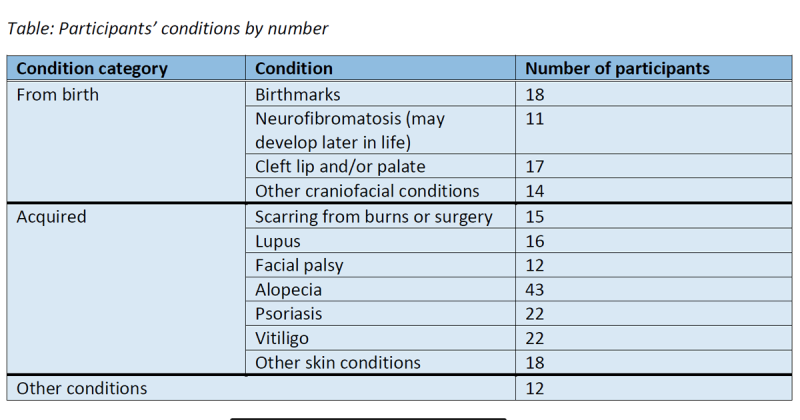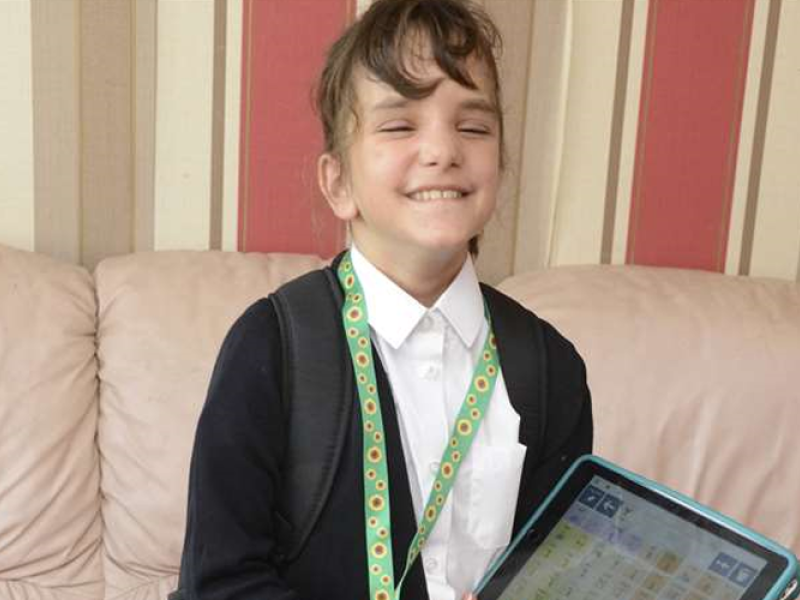Looks and Life: A summary of the study
23 August 2019
Looks and Life: A summary of the study
What we wanted to learn
We were interested in how people with a health condition that affects their appearance deal with difficult thoughts and feelings about their appearance. We know from previous research that some people avoid activities that they expect will bring up difficult thoughts and feelings, and some spend a lot of time and energy covering, concealing and focusing on their appearance. We wanted to learn more about two mental tendencies: (1) a desire to get rid of or avoid difficult thoughts and feelings (called ‘experiential avoidance), and (2) getting caught up with difficult thoughts (called ‘cognitive fusion’). Specifically, we wanted to know whether these two tendencies might explain why people with conditions that affect their appearance are more or less likely to (a) avoid stressful appearance-related activities, and (b) to cover, conceal and focus on their appearance.
What we did
To do this, we asked charities and organisations from the Appearance Collective to help us recruit participants across a wide range of appearance-affecting conditions (a breakdown by condition type is given below). Thanks to these organisations, we surveyed 220 adults, aged 18-75, just under 80% of whom were female. Participants completed demographic questions, a series of validated psychological questionnaires, and gave details about how their condition affects their appearance. We ran statistical analyses called Mediation analyses, to find out how well (1) experiential avoidance and (2) cognitive fusion statistically explained participants’ tendency to (a) avoid stressful appearance-related situations and (b) cover, conceal and focus on their appearance. In the analyses, we took account of participants’ age, gender, how visible they perceived their different appearance to be to others, and whether their condition was acquired or from birth.
What we found
We found that participants’ level of (1) experiential avoidance (a tendency to try and get rid of or avoid difficult thoughts and feelings) did partly explain their tendency to (a) avoid stressful appearance-related situations. The more experientially avoidant they were, the more likely they were to avoid stressful situations. Experiential avoidance didn’t, though, explain participants’ tendency to (b) cover, conceal and focus on appearance. On the other hand, participants’ level of (2) cognitive fusion (getting caught up in thoughts) explained both (a) avoiding stressful situations and (b) cover, concealing and focusing on appearance. The more participants were caught up in thoughts, the more they’d avoid stressful situations, and the more they’d cover, conceal and focus on their appearance.
What this means
We now know that these two mental tendencies are likely to play a role in how people cope with difficult thoughts and feelings about their appearance. Many types of psychological therapy (like traditional cognitive behavioural therapy) try to help people manage distress by teaching them to change their thinking patterns from less rational to more rational. What the findings of the study suggest is that they may be another way: Learning to just observe thoughts as thoughts rather than facts (‘cognitive defusion’) and learning to open up to and tolerate difficult thoughts and feelings (‘experiential acceptance’), without trying to change those internal experiences, may help people with appearance-affecting conditions engage more in meaningful activities that they may otherwise avoid. An approach called Acceptance and Commitment Therapy (or ‘ACT’) focuses on developing cognitive defusion and experiential acceptance, and we at CAR are currently developing a self-help programme based on ACT that we would like to test in the near future.

Filter News

2019 NF Conference
Find out more about the 2019 NF Conference being hosted by our friends across the pond the CTF
Read More
Kate Swallow’s Fantastic Fundraiser at the Tipsy Pig
Find out more about the succesful and throughly enjoyed charity music event hosted by Kate Swallow at the Tipsy Pig
Read More
Support Specialist: One of Many Cases
Have a read about a specific case study detailing the kind of work our support specialists offer to those with NF
Read More
Thank You James Gamble!
James Gamble just completed an incredible fundraiser in which he has cycled a total of 980 miles for NTUK! Find out more here
Read More
Teagan Martin’s first day at Canterbury Secondary School
Have a read about the incredible young girl who continues to defy the odds here
Read More
Kloe van der Merwe - Our NF hero as told by Mum Candice
Hear about the incredibly brave young girl as told by her Mum Candice
Read More
Wass’ Everyday Battlers 10K Stratford Run
Wassim is running the 10K Stratford Run for Nerve Tumours UK. Here he explains his reasons as to why:
Read More
Megan’s Skyfall
Megan is undertaking a sponsored skydive for NTUK as part of her travels! Find out more here
Read More
Glen’s Half Marathon in Support of his Nephew Freddie.
Have a read about the special young boy who has inspired his uncle take on the New Forest Half Marathon
Read More
